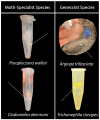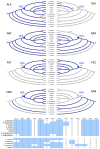Special Prey, Special Glue: NMR Spectroscopy on Aggregate Glue Components of Moth-Specialist Spiders, Cyrtarachninae
- PMID: 38786466
- PMCID: PMC11117802
- DOI: 10.3390/biomimetics9050256
Special Prey, Special Glue: NMR Spectroscopy on Aggregate Glue Components of Moth-Specialist Spiders, Cyrtarachninae
Abstract
Orb-weaver spiders produce upwards of seven different types of silk, each with unique material properties. We focus on the adhesive within orb-weaving spider webs, aggregate glue silk. These droplets are composed of three main components: water, glycoproteins, and a wide range of low molecular mass compounds (LMMCs). These LMMCs are known to play a crucial role in maintaining the material properties of the glycoproteins, aid in water absorption from the environment, and increase surface adhesion. Orb-weavers within the Cyrtarachninae subfamily are moth specialists and have evolved glue droplets with novel material properties. This study investigated the biochemical composition and diversity of the LMMCs present in the aggregate glue of eight moth-specialist species and compared them with five generalist orb-weavers using nuclear magnetic resonance (NMR) spectroscopy. We hypothesized that the novel drying ability of moth-specialist glue was accompanied by novel LMMCs and lower overall percentages by silk weight of LMMCs. We measured no difference in LMMC weight by the type of prey specialization, but observed novel compositions in the glue of all eight moth-catching species. Further, we quantified the presence of a previously reported but unidentified compound that appears in the glue of all moth specialists. These silks can provide insight into the functions of bioadhesives and inform our own synthetic adhesives.
Keywords: Cyrtarachninae; NMR; aggregate glue; arachnology; bolas; spider silk.
Conflict of interest statement
The authors declare no conflicts of interest.
Figures










References
-
- Opell B.D., Bond J.E. Capture Thread Extensibility of Orb-Weaving Spiders: Testing Punctuated and Associative Explanations of Character Evolution. Biol. J. Linn. Soc. 2000;70:107–120. doi: 10.1006/bijl.1999.0390. - DOI
-
- Sahni V., Blackledge T.A., Dhinojwala A. A Review on Spider Silk Adhesion. J. Adhes. 2011;87:595–614. doi: 10.1080/00218464.2011.583588. - DOI
-
- Foelix R. Biology of Spiders. Oxford University Press; New York, NY, USA: 2011.
Grants and funding
LinkOut - more resources
Full Text Sources

